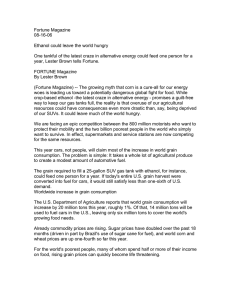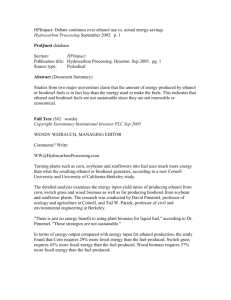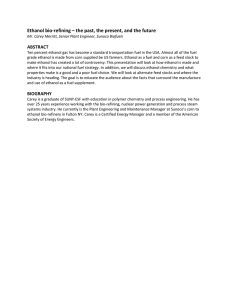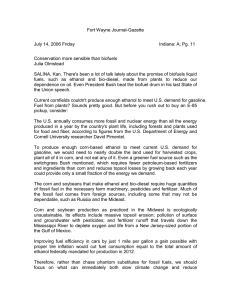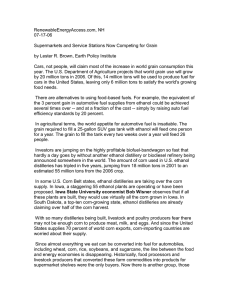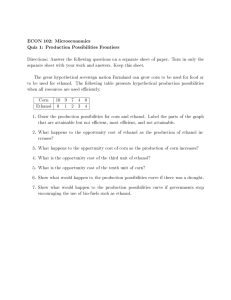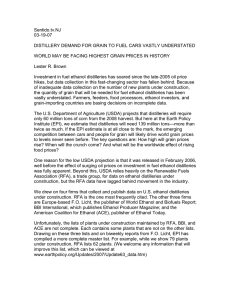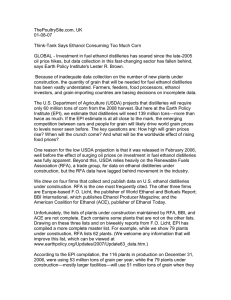Truth about Trade and Technology, IA 09-12-06
advertisement
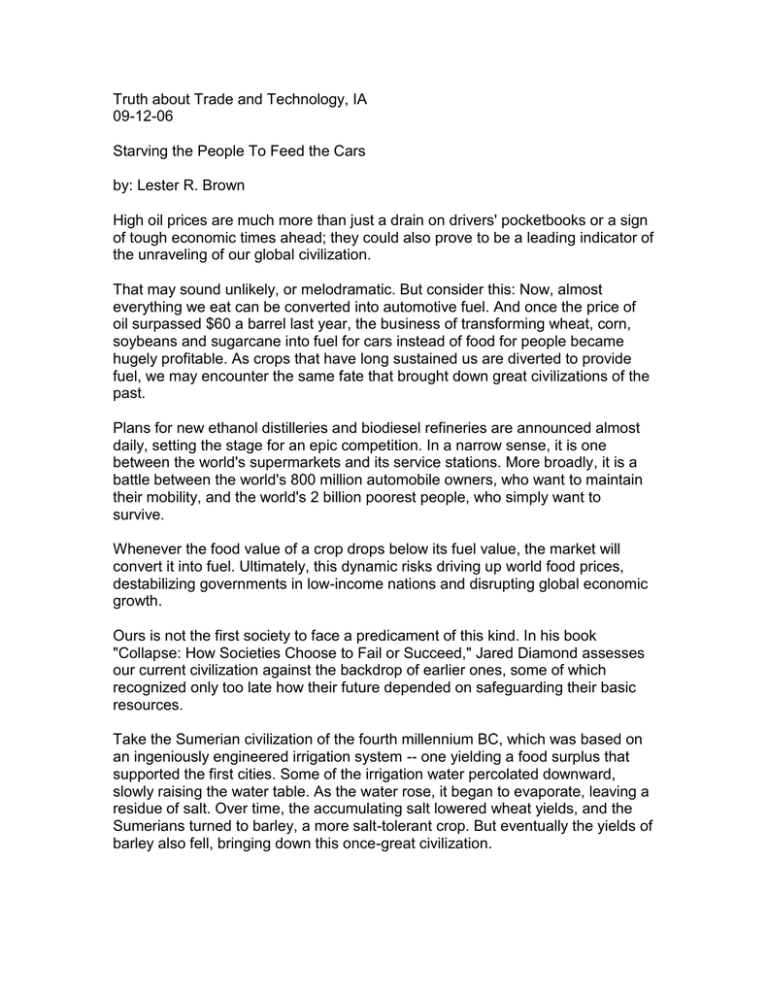
Truth about Trade and Technology, IA 09-12-06 Starving the People To Feed the Cars by: Lester R. Brown High oil prices are much more than just a drain on drivers' pocketbooks or a sign of tough economic times ahead; they could also prove to be a leading indicator of the unraveling of our global civilization. That may sound unlikely, or melodramatic. But consider this: Now, almost everything we eat can be converted into automotive fuel. And once the price of oil surpassed $60 a barrel last year, the business of transforming wheat, corn, soybeans and sugarcane into fuel for cars instead of food for people became hugely profitable. As crops that have long sustained us are diverted to provide fuel, we may encounter the same fate that brought down great civilizations of the past. Plans for new ethanol distilleries and biodiesel refineries are announced almost daily, setting the stage for an epic competition. In a narrow sense, it is one between the world's supermarkets and its service stations. More broadly, it is a battle between the world's 800 million automobile owners, who want to maintain their mobility, and the world's 2 billion poorest people, who simply want to survive. Whenever the food value of a crop drops below its fuel value, the market will convert it into fuel. Ultimately, this dynamic risks driving up world food prices, destabilizing governments in low-income nations and disrupting global economic growth. Ours is not the first society to face a predicament of this kind. In his book "Collapse: How Societies Choose to Fail or Succeed," Jared Diamond assesses our current civilization against the backdrop of earlier ones, some of which recognized only too late how their future depended on safeguarding their basic resources. Take the Sumerian civilization of the fourth millennium BC, which was based on an ingeniously engineered irrigation system -- one yielding a food surplus that supported the first cities. Some of the irrigation water percolated downward, slowly raising the water table. As the water rose, it began to evaporate, leaving a residue of salt. Over time, the accumulating salt lowered wheat yields, and the Sumerians turned to barley, a more salt-tolerant crop. But eventually the yields of barley also fell, bringing down this once-great civilization. The New World counterpart to Sumer was the Mayan civilization in the lowlands of southern Mexico and Guatemala, a society that flourished from AD 250 until around AD 900. But deforestation and the resulting soil erosion undermined their agriculture. Today this region is covered in jungle, reclaimed by nature, and the Mayan civilization is a mere archaeological curiosity. Some early societies recognized environmental trouble and fashioned an effective response. In the 15th century, Icelanders realized that overgrazing of their grasslands was leading to soil erosion. Farmers then calculated how many sheep the land could sustain and allocated quotas among themselves, thus preserving their grasslands -- and a wool industry that thrives today. What salt levels, deforestation and soil erosion foretold for past societies, high oil prices could reveal about our own. Among the many environmental threats to our future -- increasing CO2levels, melting ice sheets, rising sea levels, falling water tables and shrinking forests -the depletion of oil reserves may be the most immediate for our oil-based global civilization. The price of oil has more than tripled over the past four years, jumping from $20 to nearly $70 a barrel. Mainstream analysts talk about prices rising to $100 a barrel or more if major disruptions in supply occur -- such as the explosion of violence and chaos in the oil-rich Middle East. And even though the discovery of oil reserves last week beneath the Gulf of Mexico was hailed as a boost for the U.S. oil industry, it will only temporarily delay the ongoing depletion. The real news is that so few such discoveries are made. These runaway oil prices are now driving biofuel production, once spurred mainly by government subsidies. Brazil, the world's largest exporter of sugar, converts half of its crop into ethanol for cars, contributing to a doubling of the world sugar price over the past two years. In Europe, where rapeseed is grown for both biodiesel and cooking, margarine manufacturers have asked the European Parliament for protection from the heavily subsidized biodiesel refineries. However, it is Malaysia, the leading producer and exporter of palm oil -- the most widely used vegetable oil -- that plans to lead the world in biodiesel production. Within the past 18 months, it has approved 52 proposals to build palm-oil refineries, raising doubts as to whether there will be enough palm oil to satisfy its export commitments and to feed these refineries. And in the United States, investors are jumping on the biofuel bandwagon, pumping billions into new ethanol distilleries and biodiesel refineries. Last year, the United Sates produced more than 4 billion gallons of ethanol. Corn use by the ethanol distilleries has increased from 18 million tons in 2001 to an estimated 55 million tons from the 2006 crop, or nearly one-sixth of the U.S. grain harvest. In some Corn Belt states, ethanol distilleries are taking over the corn supply. In Iowa, a staggering 55 ethanol plants are already operating or are planned. Iowa State University economist Bob Wisner observes that if all these plants are completed, they would use virtually the entire Iowa corn harvest. With so many distilleries being built, livestock producers fear there may not be enough corn to feed animals, possibly leading to shortages in milk, eggs, beef, pork and poultry. And because the United States supplies 70 percent of world corn exports, importing countries -- such as Egypt, Japan and Mexico -- should be worried, too. In agricultural terms, our appetite for automotive fuel is insatiable: The grain required to fill a 25-gallon SUV gas tank with ethanol would feed one person for a full year. If the United States converted its entire grain harvest into ethanol, it would satisfy less than 16 percent of its automotive fuel needs. Yet, no one in the United States or internationally is monitoring the escalating diversion of grain to fuel distilleries to ensure that it will not disrupt food supplies. Instead, a market free-for-all dominates, with commodities going to the highest bidder. All of this is unfolding as the world's farmers are trying to feed 76 million additional people each year. In six of the past seven years, world grain consumption has exceeded production. As a result, the reserve of public and private grain stocks that we rely on as a carryover from harvest to harvest has fallen to the lowest level in 34 years. There are alternatives to this food-based fuels scenario. The equivalent of a 3 percent gain in U.S. automotive fuel supplies from ethanol could be achieved several times over -- and at a fraction of the cost -- simply by raising automobile fuel-efficiency standards by 20 percent. We can also shift to highly efficient gaselectric hybrid plug-in vehicles. And if we invest in wind farms, feeding cheap electricity into the grid, cars could run primarily on wind energy, and at the gasoline equivalent of less than $1 a gallon. Like earlier civilizations, we face a choice. When the Sumerians got into trouble on the food front, they substituted barley for wheat, which delayed but did not prevent their ultimate decline. We are similarly substituting ethanol for oil, treating the symptoms rather than the cause. The question is whether we will move quickly enough to reduce our dependence on oil, or whether we will continue with business as usual. Will we choose to follow the Icelanders, or the Sumerians and Mayans?

